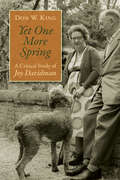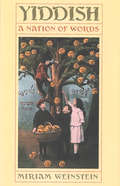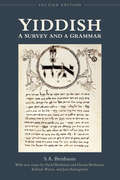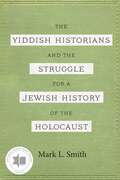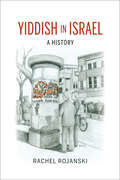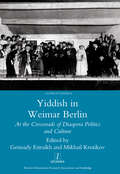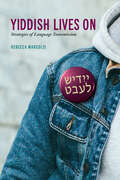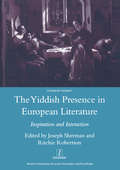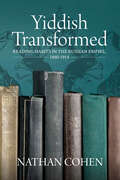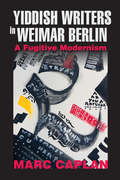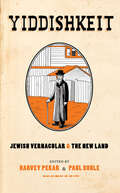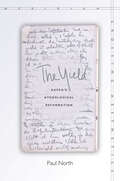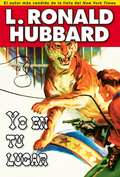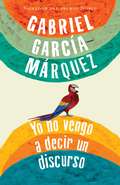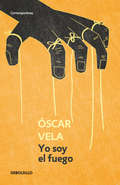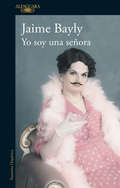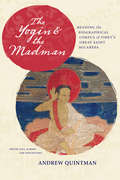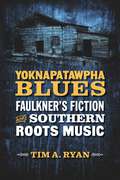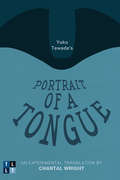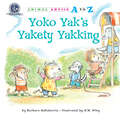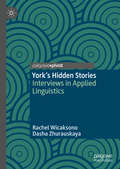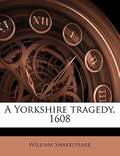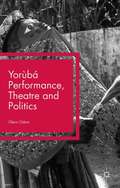- Table View
- List View
Yet One More Spring: A Critical Study of Joy Davidman
by Don W. KingThe first comprehensive study of a gifted but largely overlooked American writer Joy Davidman (1915–1960) is probably best known today as the woman that C. S. Lewis married in the last decade of his life. But she was also an accomplished writer in her own right — an award winning poet and a prolific book, theater, and film reviewer during the late 1930s and early 1940s.Yet One More Spring is the first comprehensive critical study of Joy Davidman's poetry, nonfiction, and fiction. Don King studies her body of work — including both published and unpublished works — chronologically, tracing her development as a writer and revealing Davidman's literary influence on C. S. Lewis. King also shows how Davidman's work reflects her religious and intellectual journey from secular Judaism to atheism to Communism to Christianity. Drawing as it does on a cache of previously unknown manuscripts of Davidman's work, Yet One More Spring brings to light the work of a very gifted but largely overlooked American writer.
Yet One More Spring: A Critical Study of Joy Davidman
by Don W. KingThe first comprehensive study of a gifted but largely overlooked American writer Joy Davidman (1915–1960) is probably best known today as the woman that C. S. Lewis married in the last decade of his life. But she was also an accomplished writer in her own right — an award winning poet and a prolific book, theater, and film reviewer during the late 1930s and early 1940s.Yet One More Spring is the first comprehensive critical study of Joy Davidman's poetry, nonfiction, and fiction. Don King studies her body of work — including both published and unpublished works — chronologically, tracing her development as a writer and revealing Davidman's literary influence on C. S. Lewis. King also shows how Davidman's work reflects her religious and intellectual journey from secular Judaism to atheism to Communism to Christianity. Drawing as it does on a cache of previously unknown manuscripts of Davidman's work, Yet One More Spring brings to light the work of a very gifted but largely overlooked American writer.
Yiddish
by Miriam WeinsteinThis first-ever popular history of Yiddish is so full of life that it reads like a biography of the language.For a thousand years Yiddish was the glue that held a people together. Through the intimacies of daily use, it linked European Jews with their heroic past, their spiritual universe, their increasingly far-flung relations. In it they produced one of the world's most richly human cultures.Impoverished and disenfranchised in the eyes of the world, Yiddish-speakers created their own alternate reality - wealthy in appreciation of the varieties of human behavior, spendthrift in humor, brilliantly inventive in maintaining and strengthening community. For a people of exile, the language took the place of a nation. The written and spoken word formed the Yiddishland that never came to be. Words were army, university, city-state, territory. They were a people's home.The tale, which has never before been told, is nothing short of miraculous - the saving of a people through speech. It ranges far beyond Europe, from North America to Israel to the Russian-Chinese border, and from the end of the first millenium to the present day. This book requires no previous knowledge of Yiddish or of Jewish history - just a curious mind and an open heart.
Yiddish: A Survey and a Grammar, Second Edition
by Kalman Weiser Eleazar Birnbaum S. A. Birnbaum David Birnbaum Jean BaumgartenOne of the great Yiddish scholars of the twentieth century, S.A. Birnbaum (1891-1989) published Yiddish: A Survey and a Grammar in 1979 towards the end of a long and prolific career. Unlike other grammars and study guides for English speakers, Yiddish: A Survey and a Grammar fully describes the Southern Yiddish dialect and pronunciation used today by most native speakers, while also taking into account Northern Yiddish and Standard Yiddish, associated with secularist and academic circles. The book also includes specimens of Yiddish prose and poetic texts spanning eight centuries, sampling Yiddish literature from the medieval to modern eras across its vast European geographic expanse.The second edition of Yiddish: A Survey and a Grammar makes this classic text available again to students, teachers, and Yiddish-speakers alike. Featuring three new introductory essays by noted Yiddish scholars, a corrected version of the text, and an expanded and updated bibliography, this book is essential reading for any serious student of Yiddish and its culture.
The Yiddish Historians and the Struggle for a Jewish History of the Holocaust
by Mark L. SmithThe Yiddish Historians and the Struggle for a Jewish History of the Holocaust identifies the Yiddish historians who created a distinctively Jewish approach to writing Holocaust history in the early years following World War II. Author Mark L. Smith explains that these scholars survived the Nazi invasion of Eastern Europe, yet they have not previously been recognized as a specific group who were united by a common research agenda and a commitment to sharing their work with the worldwide community of Yiddish-speaking survivors. These Yiddish historians studied the history of the Holocaust from the perspective of its Jewish victims, focusing on the internal aspects of daily life in the ghettos and camps under Nazi occupation and stressing the importance of relying on Jewish sources and the urgency of collecting survivor testimonies, eyewitness accounts, and memoirs. With an aim to dispel the accusations of cowardice and passivity that arose against the Jewish victims of Nazism, these historians created both a vigorous defense and also a daring offense. They understood that most of those who survived did so because they had engaged in a daily struggle against conditions imposed by the Nazis to hasten their deaths. The redemption of Jewish honor through this recognition is the most innovative contribution by the Yiddish historians. It is the area in which they most influenced the research agendas of nearly all subsequent scholars while also disturbing certain accepted truths, including the beliefs that the earliest Holocaust research focused on the Nazi perpetrators, that research on the victims commenced only in the early 1960s and that Holocaust study developed as an academic discipline separate from Jewish history. Now, with writings in Yiddish journals and books in Europe, Israel, and North and South America having been recovered, listed, and given careful discussion, former ideas must yield before the Yiddish historians’ published works. The Yiddish Historians and the Struggle for a Jewish History of the Holocaust is an eye-opening monograph that will appeal to Holocaust and Jewish studies scholars, students, and general readers.
Yiddish in Israel: A History (Perspectives On Israel Studies)
by Rachel Rojanski“A pioneering study” of how two languages have coexisted in the Jewish state, with “a wealth of information” on Yiddish newspapers, theater, and more (AJS Review).Yiddish in Israel: A History challenges the commonly held view that Yiddish was suppressed or even banned by Israeli authorities for ideological reasons, offering instead a radical new interpretation of the interaction between Yiddish and Israeli Hebrew cultures. Rachel Rojanski tells the compelling unknown story of how Yiddish, the most widely used Jewish language in the pre-Holocaust world, fared in Zionist Israel, the land of Hebrew.Following Yiddish in Israel from the proclamation of the State until today, Rojanski reveals that although Israeli leadership made promoting Hebrew a high priority, it did not have a definite policy on Yiddish. The language’s varying fortune through the years was shaped by social and political developments, as well as the cultural atmosphere in Israel. Public perception of the language and its culture, the rise of identity politics, and political and financial interests all played a part.Using a wide range of archival sources, newspapers, and Yiddish literature, Rojanski follows the Israeli Yiddish scene through the history of the Yiddish press, Yiddish theater, early Israeli Yiddish literature, and high Yiddish culture. With compassion, she explores the tensions during Israel’s early years between Yiddish writers and activists and Israel’s leaders, most of whom were themselves Eastern European Jews balancing their love of Yiddish with their desire to promote Hebrew. Finally Rojanski follows Yiddish into the twenty-first century, telling the story of the revived interest in Yiddish among Israeli-born children of Holocaust survivors as they return to the language of their parents.
Yiddish in Weimar Berlin: At the Crossroads of Diaspora Politics and Culture
by Gennady Estraikh"Berlin emerged from the First World War as a multicultural European capital of immigration from the former Russian Empire, and while many Russian emigres moved to France and other countries in the 1920s, a thriving east European Jewish community remained. Yiddish-speaking intellectuals and activists participated vigorously in German cultural and political debate. Multilingual Jewish journalists, writers, actors and artists, invigorated by the creative atmosphere of the city, formed an environment which facilitated exchange between the main centres of Yiddish culture: eastern Europe, North America and Soviet Russia. All this came to an end with the Nazi rise to power in 1933, but Berlin remained a vital presence in Jewish cultural memory, as is testified by the works of Sholem Asch, Israel Joshua Singer, Zalman Shneour, Moyshe Kulbak, Uri Zvi Grinberg and Meir Wiener. This volume includes contributions by an international team of leading scholars dealing with various aspects of history, arts and literature, which tell the dramatic story of Yiddish cultural life in Weimar Berlin as a case study in the modern European culture."
Yiddish Lives On: Strategies of Language Transmission
by Rebecca MargolisThe language of a thousand years of European Jewish civilization that was decimated in the Nazi Holocaust, Yiddish has emerged as a vehicle for young people to engage with their heritage and identity. Although widely considered an endangered language, Yiddish has evolved as a site for creative renewal in the Jewish world and beyond in addition to being used daily within Hasidic communities. Yiddish Lives On explores the continuity of the language in the hands of a diverse group of native, heritage, and new speakers. The book tells stories of communities in Canada and abroad that have resisted the decline of Yiddish over a period of seventy years, spotlighting strategies that facilitate continuity through family transmission, theatre, activism, publishing, song, cinema, and other new media. Rebecca Margolis uses a multidisciplinary approach that draws on methodologies from history, sociolinguistics, ethnography, digital humanities, and screen studies to examine the ways in which engagement with Yiddish has evolved across multiple planes.Investigating the products of an abiding dedication to cultural continuity among successive generations, Yiddish Lives On offers innovative approaches to the preservation, promotion, and revitalization of minority, heritage, and lesser-taught languages.
The Yiddish Presence in European Literature: Inspiration and Interaction: Selected Papers Arising from the Fourth and Fifth International Mendel Friedman Conference
by Joseph Sherman"Early in the twentieth century, Yiddish, previously stigmatized as a corrupt jargon, came to be recognized as a language in its own right, and one moreover that was already the vehicle for a rich literature. Many writers in other European languages steadily became aware of the status and richness of the Yiddish language, sometimes by encountering Yiddish-speaking communities in Eastern Europe, and they responded to Yiddish language and culture in their own works, while Yiddish writers adopted, and sometimes anticipated, modern trends in other European literatures known to them. The collection of papers in this volume examines some of these fruitful interactions between Yiddish and the European literary tradition, ranging from the early nineteenth century to the present, from France to Lithuania, and from classic modernist writers such as Kafka to Imre Kertesz (Nobel Prize for Literature, 2002). With the contributions: Gilles Rozier- 'When Purim-shpiler meets Columbine': Characters of Commedia dell'arte and Purimshpil in the Works of Moyshe Broderzon David Bellos- In the Worst Possible Taste: Romain Gary's Dance of Genghis Cohn Florian Krobb- 'Muthwillige Faschingstracht': The Presence of Yiddish in Nineteenth-Century German Literature Ritchie Robertson- Kafka's Encounter with the Yiddish Theatre David Groiser- Translating Yiddish: Martin Buber and David Pinski Mikhail Krutikov- Yiddish Author as Cultural Mediator: Meir Wiener's Unpublished Novel David Midgley- The Romance of the East: Encounters of German-Jewish Writers with Yiddish-Speaking Communities, 1916-27 PolO Dochartaigh - Intimacy and Alienation: Yiddish in the Works of Jurek Becker Peter Sherwood- 'Living through Something': Notes on the Work of Imre Kertesz Joseph Sherman- Bergelson and Chekhov: Convergences and Departures Gennady Estraikh- Shmuel Gordon: A Yiddish Writer in 'the Ocean of Russian Literature'"
Yiddish Transformed: Reading Habits in the Russian Empire, 1860-1914
by Nathan CohenAs significant economic, social, political, and cultural transformations swept the Jewish population of Tsarist Russia and Congress Poland between 1860 and 1914, the Yiddish language (Zhargon) began to gain recognition as a central part of the Jewish cultural stage. Yiddish Transformed examines the secular reading habits of East-European Jews as the Jewish community began shifting to a modern society. Author Nathan Cohen explores Jewish reading practices alongside the rise of Yiddish by delving into publishing policies of Yiddish books and newspapers, popular literary genres of the time, the development of Jewish public libraries, as well as personal reflections of reading experiences.
Yiddish Writers in Weimar Berlin: A Fugitive Modernism (German Jewish Cultures)
by Marc CaplanIn Yiddish Writers in Weimar Berlin, Marc Caplan explores the reciprocal encounter between Eastern European Jews and German culture in the days following World War I. By concentrating primarily on a small group of avant-garde Yiddish writers—Dovid Bergelson, Der Nister, and Moyshe Kulbak—working in Berlin during the Weimar Republic, Caplan examines how these writers became central to modernist aesthetics. By concentrating on the character of Yiddish literature produced in Weimar Germany, Caplan offers a new method of seeing how artistic creation is constructed and a new understanding of the political resonances that result from it. Yiddish Writers in Weimar Berlin reveals how Yiddish literature participated in the culture of Weimar-era modernism, how active Yiddish writers were in the literary scene, and how German-speaking Jews read descriptions of Yiddish-speaking Jews to uncover the emotional complexity of what they managed to create even in the midst of their confusion and ambivalence in Germany. Caplan's masterful narrative affords new insights into literary form, Jewish culture, and the philosophical and psychological motivations for aesthetic modernism.
Yiddishkeit: Jewish Vernacular & the New Land
by Harvey Pekar and Paul BuhleA “fascinating and enlightening” collection of comics and writings that explore the Yiddish language and the Jewish experience (The Miami Herald).We hear words like nosh, schlep, and schmutz, but how did they come to pepper American English? In Yiddishkeit, Harvey Pekar and Paul Buhle trace the far-reaching influences of Yiddish from medieval Europe to the tenements of New York’s Lower East Side. This comics anthology contains original stories by such notable writers and artists as Barry Deutsch, Peter Kuper, Spain Rodriguez, and Sharon Rudahl. Through illustrations, comics art, and a full-length play, four major themes are explored: culture, performance, assimilation, and the revival of the language. “The book is about what Neal Gabler in his introduction labels ‘Jewish sensibility.’…he writes: ‘You really can’t define Yiddishkeit neatly in words or pictures. You sort of have to feel it by wading into it.’ The book does this with gusto.” —TheNew York Times“As colorful, bawdy, and charming as the culture it seeks to represent.” —Print magazine“Brimming with the charm and flavor of its subject…a genuinely compelling, scholarly comics experience.” —Publishers Weekly“A book that truly informs about Jewish culture and, in the process, challenges readers to pick apart their own vocabulary.” —Chicago Tribune“A postvernacular tour de force.” —The Forward“With a loving eye Pekar and Buhle extract moments and personalities from Yiddish history.” —Hadassah“Gorgeous comix-style portraits of Yiddish writers.”––Tablet “Yiddishkeit has managed to survive, if just barely…because [it] is an essential part of both the Jewish and the human experience.” —Neal Gabler, author of An Empire of Their Own: How the Jews Invented Hollywood, from his introduction“A scrumptious smorgasbord of comics, essays, and illustrations…concentrated tastes, with historical context, of Yiddish theater, literature, characters and culture.” —Heeb magazine
The Yield: Kafka's Atheological Reformation
by Paul NorthThe Yield is a once-in-a-generation reinterpretation of the oeuvre of Franz Kafka. At the same time, it is a powerful new entry in the debates about the supposed secularity of the modern age. Kafka is one of the most admired writers of the last century, but this book presents us with a Kafka few will recognize. It does so through a fine-grained analysis of the three hundred "thoughts" the writer penned near the end of World War I, when he had just been diagnosed with tuberculosis. Since they were discovered after Kafka's death, the meaning of the so-called "Zürau aphorisms" has been open to debate. Paul North's elucidation of what amounts to Kafka's only theoretical work shows them to contain solutions to problems Europe has faced throughout modernity. Kafka offers responses to phenomena of violence, discrimination, political repression, misunderstanding, ethnic hatred, fantasies of technological progress, and the subjugation of the worker, among other problems. Reflecting on secular modernity and the theological ideas that continue to determine it, he critiques the ideas of sin, suffering, the messiah, paradise, truth, the power of art, good will, and knowledge. Kafka's controversial alternative to the bad state of affairs in his day? Rather than fight it, give in. Developing some of Kafka's arguments, The Yield describes the ways that Kafka envisions we can be good by "yielding" to our situation instead of striving for something better.
Yo en tu lugar
by L. Ronald HubbardEl pequeo Tom es un enano de circo con sueos de gigante. Puede que sea el rey de los enanos, pero tiene ambiciones mayores: convertirse en el jefe de pista. Ahora, recurriendo a oscuros secretos antiguos, est a punto de conseguir su deseo: un diminuto Cheech Marin que se transforma en Omar Sharif. Pero al asumir la identidad de otro hombre, Tom debe tambin enfrentarse a sus enemigos. . . que quieren hacerle pagar por los pecados del gran hombre.
Yo no vengo a decir un discurso
by Gabriel García Márquez¿Qué hago yo encaramado en esta percha de honor, yo que siempre he considerado los discursos como el más terrorífico de los compromisos humanos? Gabriel García Márquez Los textos que Gabriel García Márquez ha reunido en este libro fueron escritos por el autor con la intención de ser leídos por él mismo en público, ante una audiencia, y recorren prácticamente toda su vida, desde el primero, que escribe a los diecisiete años para despedir a sus compañeros del curso superior en Zipaquirá, hasta el que lee ante las Academias de la Lengua y los reyes de España al cumplir ochenta años. Estos discursos del premio Nobel nos ayudan a comprender más profundamente su vida y nos desvelan sus obsesiones fundamentales como escritor y ciudadano: su fervorosa vocación por la literatura, la pasión por el periodismo, su inquietud ante el desastre ecológico que se avecina, su propuesta de simplificar la gramática, los problemas de su tierra colombiana o el recuerdo emocionado de amigos escritores como Julio Cortázar o Álvaro Mutis, entre otros muchos. El lector tiene entra sus manos el complemento indispensable a una obra narrativa que nos seguirá hablando en un largo porvenir. **** What am I doing here on this perch of honor, when I have always considered speeches the most terrifying of human obligations? The speeches that Gabriel García Márquez has gathered in this collection were written by the author with the intention of being read by him before an audience, and span the course of nearly his entire life; from the first, a farewell written at seventeen to his fellow students at Zipaquirá, to his appearance before the Spanish-language Academies and the kings of Spain on his eightieth birthday. Combined, these speeches provide a more profound understanding of the life of this Nobel Prize winner, revealing his fundamental creative and civil obsessions: his intense aptitude for literature and writing; his passion for journalism; his concerns over looming environmental dangers; his proposal for the simplification of grammar; the problems facing his beloved Colombian homeland; and the loving memory of fellow writers like Julio Cortázar and Álvaro Mutis, among many others. In Yo no vengo a decir un discurso (I did not come to give a speech), the reader holds in his/her hands the essential complement to a body of work that will continue speaking to us for a long time to come.
Yo soy el fuego
by Oscar VelaConsumidos por las tinieblas.Devorados por el fuego. Yo soy el fuego es un vertiginoso viaje hacia lo más sombrío de lamiseria humana. Sus personajes se embarcan en ruines empresas ignorandoque son marionetas de seres superiores. Beatriz y el Dragón portan laluz imperecedera del fuego, único elemento capaz de combatir laoscuridad; ese fuego que calcina y carboniza, pero que también sana ypurifica«Mientras, la mirada del Dragón se pierde en una gran masa pirotécnica,que parece penetrar con sus pupilas abriendo en el medio de ella unenorme orificio. Y allí está otra vez el aro mágico iluminando la noche,un gran cerco incandescente que parece aguardar al gigantesco tigre quelo atravesará de un salto, perforando el centro del aro con su cuerpobrillante».Reseña:«Con una prosa impecable y un manejo virtuoso de los distinto puntos devista, Oscar Vela nos introduce en el mundo de personajes que queremosconocer de inmediato. Difícil dejar de leer su novela hasta no respondera ciertas preguntas: ¿Qué será capaz de hacer Ramiro Leone? ¿Quién esese joven que salvó su vida gracias a la biblioteca de El Tata? ¿A quiénle habla el narrador en segunda persona? Pero sobre todo, ¿quérepresenta el fuego para todos ellos?».Claudia Piñeiro
Yo soy una señora
by Jaime Bayly"Yo desde chica, he sido muy de derecha. Nunca he sido comunista, tan bruta no soy. He sido marihuanera, pero no comunista, he sido marihuanera de derecha". Una mujer adicta al sexo, un esposo tarado que escoge los regalos más inadecuados para su mujer, una azafata que sueña con jubilarse, una locutora radial de madrugada, una derechista pistolera, una pintora que no consigue vender sus cuadros. Este universo de personajes, esta fauna de seres delirantes, es la que habita en Yo soy una señora. En estos cuentos, atravesados por el humor y la ironía, el autor ha logrado un registro oral que transita entre la confesión de parte, el relato testimonial y el chisme. Usted, lector, tendrá la impresión de estar sentado en alguna sala de espera junto a un extraño que, sin ninguna vergüenza, compartirá los detalles más privados de su vida, esos de los que normalmente nadie quiere hablar, pero que, a decir verdad, todos disfrutamos escuchar.
The Yogin and the Madman: Reading the Biographical Corpus of Tibet's Great Saint Milarepa (South Asia Across the Disciplines)
by Andrew QuintmanTibetan biographers began writing Jetsun Milarepa's (1052–1135) life story shortly after his death, initiating a literary tradition that turned the poet and saint into a model of virtuosic Buddhist practice throughout the Himalayan world. Andrew Quintman traces this history and its innovations in narrative and aesthetic representation across four centuries, culminating in a detailed analysis of the genre's most famous example, composed in 1488 by Tsangnyön Heruka, or the "Madman of Western Tibet." Quintman imagines these works as a kind of physical body supplanting the yogin's corporeal relics.
Yoknapatawpha Blues: Faulkner's Fiction and Southern Roots Music (Southern Literary Studies)
by Tim A. RyanDuring the 1920s and 1930s, Mississippi produced two of the most significant influences upon twentieth-century culture: the modernist fiction of William Faulkner and the recorded blues songs of African American musicians like Charley Patton, Geeshie Wiley, and Robert Johnson. In Yoknapatawpha Blues, the first book examining both Faulkner and the music of the south, Tim A. Ryan identifies provocative parallels of theme and subject in diverse regional genres and texts. Placing Faulkner's literary texts and prewar country blues song lyrics on equal footing, Ryan illuminates the meanings of both in new and unexpected ways. He provides close analysis of the Great Mississippi Flood of 1927 in Faulkner's "Old Man" and Patton's "High Water Everywhere"; racial violence in the story "That Evening Sun" and Wiley's "Last Kind Words Blues"; and male sexual dysfunction in Sanctuary and Johnson's "Dead Shrimp Blues." This interdisciplinary study reveals how the characters of Yoknapatawpha County and the protagonists in blues songs similarly strive to assert themselves in a threatening and oppressive world. By emphasizing the modernism found in blues music and the echoes of black vernacular culture in Faulkner's writing, Yoknapatawpha Blues links elucidates the impact of both Faulkner's fiction and roots music on the culture of the modern South, and of the nation.
Yoko Tawada's Portrait of a Tongue: An Experimental Translation by Chantal Wright (Literary Translation)
by Yoko TawadaYoko Tawada's Portrait of a Tongue: An Experimental Translation by Chantal Wright is a hybrid text, innovatively combining literary criticism, experimental translation, and scholarly commentary. This work centres on a German-language prose text by Yoko Tawada entitled ‘Portrait of a Tongue’ [‘Porträt einer Zunge’, 2002]. Yoko Tawada is a native speaker of Japanese who learned German as an adult. Portrait of a Tongue is a portrait of a German woman—referred to only as P—who has lived in the United States for many years and whose German has become inflected by English. The text is the first-person narrator’s declaration of love for P and for her language, a ‘thinking-out-loud’ about language(s), and a self-reflexive commentary. Chantal Wright offers a critical response and a new approach to the translation process by interweaving Tawada’s text and the translator’s dialogue, creating a side-by-side reading experience that encourages the reader to move seamlessly between the two parts. Chantal Wright’s technique models what happens when translators read and responds to calls within Translation Studies for translators to claim visibility, to practice “thick translation”, and to develop their own creative voices. This experimental translation addresses a readership within the academic disciplines of Translation Studies, Germanic Studies, and related fields. - This book is published in English.
Yoko Yak's Yakety Yakking (Animal Antics A to Z)
by Barbara deRubertisYodel-odel-odel, yak yak yak! Yoko Yak can’t seem to stop chatting! And it makes her classmates wonder—what do you do with a yakety yak?
Yooper Talk: Dialect as Identity in Michigan's Upper Peninsula
by Kathryn A. RemlingerYooper Talk is a fresh and significant contribution to understanding regional language and culture in North America. The Upper Peninsula of Michigan—known as "the UP"—is historically, geographically, and culturally distinct. Struggles over land, labor, and language during the last 150 years have shaped the variety of English spoken by resident Yoopers, as well as how they are viewed by outsiders. Drawing on sixteen years of fieldwork, including interviews with seventy-five lifelong residents of the UP, Kathryn Remlinger examines how the idea of a unique Yooper dialect emerged. Considering UP English in relation to other regional dialects and their speakers, she looks at local identity, literacy practices, media representations, language attitudes, notions of authenticity, economic factors, tourism, and contact with immigrant and Native American languages. The book also explores how a dialect becomes a recognizable and valuable commodity: Yooper talk (or "Yoopanese") is emblazoned on t-shirts, flags, postcards, coffee mugs, and bumper stickers. Yooper Talk explains linguistic concepts with entertaining examples for general readers and also contributes to interdisciplinary discussions of dialect and identity in sociolinguistics, anthropology, dialectology, and folklore.
York's Hidden Stories: Interviews in Applied Linguistics
by Rachel Wicaksono Dasha ZhurauskayaThis book explores the mechanics of storytelling within a study aimed at focusing on a ‘hidden’ population of migrants in the city of York, UK. Taking applied linguistics to mean the consideration of real-world ‘problems’ as identified by a ‘client’, in which the use of (and beliefs about) language is a significant component, the authors describe the benefits and challenges of working in a partnership with a community organisation. With project participants from Africa, Europe, Asia and South and Central America who had lived in York between two and fifty years, the study considers the co-construction of meaning in interviews from a range of practical and theoretical perspectives. The book will be of interest to students, academic researchers and community project leaders who are interested in migration stories and interviews as a method of data collection.
A Yorkshire Tragedy
by ShakespeareThe plot of the play is based on the biographical account of Walter Calverley of Calverley Hall, Yorkshire, who was executed on 5 August 1605 for murdering two of his children and stabbing his wife. <P> <P> The crimes were a well-known scandal of the day; a pamphlet on the case was issued in June 1605, with a ballad following in July. The chronicler John Stow reported the case in his Annals.[1][2] The murders were also dramatised in a play titled The Miseries of Enforced Marriage (1607), by George Wilkins. Scholars have disagreed on the relationship between Wilkins's play and A Yorkshire Tragedy; some of have seen one play as a source for the other, or even the work of the same author, while others regard the two dramas as essentially separate works.[3]
Yorùbá Performance, Theatre and Politics
by Glenn OdomThis book explains the connections between traditional performance (e.g. masked dances, prophecy, praise recitations), contemporary theatre (Wole Soyinka, Ola Rotimi, Tess Onwueme, Femi Osofisan, and Stella Oyedepo) , and the political sphere in the context of the Yorùbá people in Nigeria.
